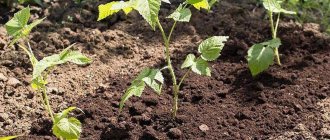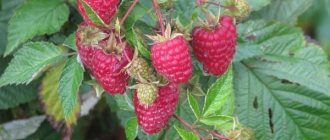History of the variety's creation
This raspberry variety was bred by Canadian breeders in the last quarter of the last century, and a patent for this horticultural crop was issued in Canada in 1989. The name of this variety of raspberries was given in honor of the river and the ancient settlement of the same name in Canada.
Since this raspberry was bred in a northern country, it is perfect for growing in most Russian regions. But still, the highest yield can be achieved from this variety by growing it in the south of Russia. In the middle zone, the Urals and Siberia, it is recommended to grow the Tulamin variety in greenhouse conditions. As a result, in conditions of a short, cold summer in closed ground, it is possible to obtain high yields from this variety, as well as significantly increase the fruiting period during the season.
Traditional raspberries Tulamin - video
Canadian pride - Tulamin raspberries
Fragrant raspberries have long been liked by residents of Russia.
The berry ripens well in the wild and is also successfully grown in home gardens. According to historical data, the first garden of raspberry seedlings was planted by the founder of Moscow, Yuri Dolgoruky, back in the 12th century. Since that distant time, breeders have been working hard to create new varieties of beautiful berries. Not only our compatriots are lovers of the wonderful fruit. In the vastness of Europe and North America, amateur and professional gardeners are also developing new types of tasty and healthy raspberries. And they have something to brag about. Meet raspberries with a standard taste called Tulamin.
Raspberry Tulamin: description of the variety
Raspberry Tulamin belongs to the mid-late varieties,
ripe fruits can be collected from the last ten days of July. Fruiting lasts more than a month - the last berries of the Tulamin variety ripen in early September. In Siberia and the Urals, where cooling begins early, the last berries may not have time to ripen in open ground.
The bushes of this variety are powerful and strong, erect. Well-leafed shoots can reach a height of 2.0 m and higher. The root growth of this raspberry variety is formed in small quantities - it is quite enough for further propagation of the raspberry plantation, but gardeners do not have to take special measures to prevent the spontaneous growth of bushes.
Photo of Tulamin raspberry
The shoots are quite strong and strong, with an average number of small thorns, and are distinguished by good growth vigor. The foliage is medium in size, slightly elongated, with sharp tips and small jagged edges. Its color is deep emerald.
The Tulamin variety has good winter hardiness, so in the southern regions and central Russia it does not need shelter before the onset of cold weather.
But in severe winters, the variety can freeze slightly if certain measures are not taken to trim and cover the bushes of this berry crop.
Black varieties
Black raspberries are not grown on an industrial scale. Breeders create black varieties to please amateur gardeners who are hungry for the exotic. Externally, the fruits of black raspberries are similar to blackberries, and their taste is often superior to them.
Ember
Mid-season variety with black, very sweet berries.
Description. If you follow agricultural techniques, the yield is high - the bush produces up to 6 kg per season. Weight of berries – 4 g. Plant height – up to 2.5 m. Arch-shaped shoots.
Pros:
- Once ripe, the berries do not fall off for a long time;
- high tasting score;
- immunity to many diseases;
- the fruits are dense - transport well, do not wrinkle, do not leak juice;
- resistance to frost.
Minuses:
- all shoots are covered with thorns;
- needs a garter.
Cumberland
Chokeberry hybrid of raspberries and blackberries. Brought out about a century ago by American breeders. It is little known in Russia, but receives good reviews from those who grow this variety on their plots. The variety is not remontant, mid-early.
Description. Falling shoots, if not pruned, grow up to 3.5 m. Fruit weight - 2 g. The color of the berries changes while they ripen - first the fruits are purple, then cherry, when they ripen - black, with a bluish bloom. One bush produces up to 10 kg of berries.
Pros:
- does not produce shoots - the plant does not “crawl” across the site;
- berries are antioxidants, increase immunity, and have antipyretic properties.
Minuses:
- there are thorns on the shoots;
- large seeds;
- cannot be planted next to blackberries and other varieties of raspberries - to avoid mixing varieties.
Main characteristics
The berries of this variety have a conical shape with blunt tips. Such fruits fit perfectly into containers for further transportation. During transportation, raspberries do not leak, but they should be laid in one layer.
The weight of each Tulamin raspberry can reach 5-6 g, the pulp is juicy, and the drupes are well adhered to each other.
Raspberry – with a pleasant strong fruity aroma. One of the advantages of this variety is the same size of fruits from the beginning of the season to the end. There is no shrinkage of the crop at the end of the season. Severing the berries from the stalks is dry.
On a note!
Raspberries of the Tulamin variety have a sweet taste with a slight sourness; the tasting rating of the fruit is 4.4 points out of 5 possible.
The harvested crop tolerates transportation well over different distances and can be stored for several days.
Ripe fruits are versatile - they can be eaten fresh, made into jam and jam, and also dried and frozen for the winter.
At the same time, the berries do not lose their taste and presentation.
Characteristics of the variety
According to gardeners, Tulamin raspberries are a fast-growing, self-fertile summer variety. There is no need to plant pollinators in the garden.
Drought resistance, frost resistance
Garden raspberries Tulamin do not tolerate low winter temperatures. The variety has winter hardiness at the level of climate zone 4. The lower temperature threshold is -29 °C. With thin snow cover, Tulamin bushes freeze slightly.
Productivity and fruiting
Following the rules of agricultural technology, from 1 bush you get from 3.5 to 4 kg of Tulamin raspberries. The variety bears fruit on shoots for 2 years. The first harvest is carried out in late July, at which time peak fruiting occurs. It continues in August.
The berries do not become smaller. Their size is the same when harvested in July and mid-to-late August. In the south, Tulamin raspberries ripen until autumn. The variety is grown not only by amateur gardeners, it is a regular in industrial gardens.
It is valued for its high yield, universal purpose of fruits, attractive cone-shaped shape, sweet, harmonious taste.
Watching the video will help you evaluate Tulamin raspberries during the peak fruiting period:
Area of application of fruits
Tulamin raspberries are shelf-stable, they are good fresh, and are suitable for winter preparations:
- drying;
- quick freezing;
- preserves, jams, marmalade, jellies;
- making homemade tinctures.
The berries are used for commercial purposes. They do not wrinkle during long-term transportation.
Resistance to diseases and pests
Judging by the reviews, the Tulamin variety has stable immunity to fungal diseases of raspberries. Acidic soil, poor care and weather disasters can trigger an epidemic.
Advice! Optimal soil moisture during the flowering period guarantees a high-quality harvest. With a lack of moisture, Tulamin berries become smaller and shoot growth slows down.
Advantages and disadvantages of the variety
Gardeners note the disadvantages of the variety. These include the cost of constructing trellises. When growing Tulamin raspberries using the trench method, they are necessary. Gartering bushes takes time. A serious drawback is freezing of bushes in the absence of snow. The advantages of the variety include:
- long fruiting period;
- stable yield;
- harmonious taste;
- marketable condition;
- keeping quality;
- transportability;
- universal purpose.
Important! The fruiting period lasts at least 50 days.
Advantages
The main advantages of the Tulamin raspberry variety include:
- good yield;
- even size of fruits and their excellent presentation;
- good plant immunity;
- the harvested crop can withstand transportation quite well over different distances; the berries are not subject to rotting during storage;
- satisfactory frost resistance of Tulamin raspberries, even if the bushes freeze slightly in winter, then in the spring lateral shoots form on them, on which fruiting occurs in the current season;
- root suckers are formed in a limited size, so gardeners do not have to remove excess growth;
- ripe fruits are distinguished by their versatility of use.
No particular disadvantages were noted for this variety.
Varieties of remontant raspberries
According to gardeners, remontant raspberries are the best representative of the genus: the harvest can be harvested several times a season, the berries are large, and fruiting is abundant. I just want to replace all traditional varieties with remontant ones and enjoy delicious, aromatic berries all summer long.
Let's consider varieties of remontant raspberries of early, medium and late ripening.
With proper care, these varieties bear fruit almost continuously.
Tulamin raspberries: features of agricultural cultivation techniques
This raspberry variety can grow in one place for at least 12 years, so you need to carefully select the place for its growth.
On a note!
The area for planting Tulamin raspberries should be level, well lit by sunlight, and the soil should be loose and fairly fertile.
Raspberry Tulamin. Digging up seedlings in the fall - video
You cannot grow Tulamin raspberries in swampy areas, where groundwater comes too close to the soil surface. Clay soils in which moisture stagnates are also not suitable for growing this berry crop, since raspberries of this variety develop poorly on such soils and can be susceptible to damage by putrefactive microorganisms.
RASPBERRIES!
Raspberry Yellow Giant Raspberry Shelf Raspberry Krasa Rossii
Purchase of planting material
Tulamin raspberry seedlings should be purchased only from trusted suppliers - in specialized nurseries or stores. If planting material with a closed root system is purchased, it can be planted in a permanent place throughout the summer season. In addition, such plants quickly acclimatize in a new place, since their root system was not injured during transportation.
Photo of Tulamin raspberry seedling
Saplings with an open root system should be planted in beds almost immediately after purchase. In this case, the soil on the site should be sufficiently warmed up (about 12-14 degrees Celsius).
When purchasing such seedlings, you need to carefully examine their root system and shoots. They should not have visible signs of disease or damage, and be strong and healthy in appearance. The length of the roots should be 20-25 cm.
Interesting article:
Preparing the garden for winter
Planting raspberries Tulamin
It is better to place raspberries along fences or buildings on the site - in this case, the plants will be protected from gusts of cold wind, and in winter the snow cover of the bushes will be plentiful.
When choosing a site, you must follow the rules of crop rotation and do not plant raspberries where potatoes, tomatoes or garden strawberries grew in the previous season.
Important!
On a garden plot, high yields of Tulamin raspberries are obtained only in the southern regions of Russia.
Photos of ways to grow remontant raspberries
When planting seedlings in the spring, beds for them need to be prepared in advance, in the fall. And when planting Tulamin raspberries in the autumn, the site needs to be prepared approximately 25-30 days before planting.
Before digging, organic and mineral fertilizers are added to the soil. 30 kg of organic fertilizers (compost, humus or rotted manure), as well as 3 tbsp., are added to each square. l. superphosphate and 2 tbsp. l. potassium salt.
You can plant raspberries in pre-prepared planting holes or trenches. The diameter of the holes should be about 0.4 m, and the depth - 0.5 m. The width and depth of the trenches should be the same dimensions. The row spacing must be at least 0.6 m.
At the bottom, mounds are formed from the soil, on which Tulamin raspberry seedlings are installed. Their roots are spread along the slopes of the mound, then the holes (or trenches) are filled with soil and compacted well. The root collar should be 2-3 cm above the soil surface.
Then the plants are watered, adding at least a bucket of water to each. The root zone of raspberries is mulched with a layer of humus or compost.
Care
Caring for this variety is not difficult, the main thing is to follow all the rules. In this case, the plant will be able to produce the best harvest.
Watering
A significant condition for the plant is moisture. An insufficient amount of water, as well as oversaturation, will negatively affect his health and condition. After planting in a permanent place, careful moistening will be required - a bucket of water 1-2 times every 7 days. With the onset of hot weather, the volume of water increases to 15 liters. In autumn, watering is also necessary. At this time, the plant forms growth points for young shoots.
Loosening
You should loosen the soil under the bushes carefully, since the roots are located close to the surface. It is better to carry out the procedure after watering. To simplify it, you can use mulching. The ideal option is sawdust, peat and hay (without seeds).
Garter
The bushes are tall, so they should be tied up. When planting separately, you will need 2 pegs between a pair of bushes. The branches of both plants are attached to them. When growing in trenches, trellises are suitable.
Summer care
When summer comes, raspberries should be given a little more attention. The main procedures that should be carried out will now be listed.
- Cut off excess shoots. They can be undermined or cut off. This way the plant will not spend additional energy on the development of young animals.
- Before flowering, you will need to spray the raspberries with copper sulfate to prevent possible diseases.
- With the beginning of the formation of ovaries, the plant is fed with organic matter. An infusion of bird droppings (1:15) works well. You will need to make a solution from it (1:10). It is enough to pour half a bucket under the bush.
Trimming
At the end of the berry picking, the fruit-bearing shoots of the previous year are pruned. Along with them, weak, diseased and damaged processes are removed. At least 9 strong branches are left on the bush, the tops of which are cut off.
Autumn care
With the onset of autumn, raspberries require moisture and feeding. During this period, the formation of buds for the next year occurs. Organic and mineral fertilizers are applied alternately. 3 buckets of manure per square meter is enough. Mineral fertilizers are applied according to instructions. Before frost, you need to remove the leaves under the bushes and dig up the soil. If there is a mulch layer, it is buried in the soil.
With the arrival of negative temperatures, the earth is dug up again. Then the leaves are removed and the branches of the plant are pinned. Next, it is covered with straw or spruce branches.
Further care for Tulamin raspberries
Its fruiting depends on further care of this raspberry variety. Particular attention should be paid to watering and fertilizing.
Irrigation regime
Watering for raspberries of this variety is very important, since it grows well and bears fruit only on sufficiently moist soils (but without stagnant moisture). It is important to add a sufficient amount of moisture during the rooting period of the planting material - after watering, the soil should be saturated with moisture to a depth of 40 cm. To do this, the bushes are watered once every 3-4 days for 25-30 days, adding at least 10 liters for each plant water. If the weather is hot, dry, add 1.5 buckets of water under the raspberries.
Important!
After each watering of Tulamin raspberries or rain, it is necessary to remove the crust that forms on the surface, loosening the root zone of the bushes. At the same time, all weeds growing in the raspberry field should be removed.
You can also mulch the beds with raspberries with compost or peat so that moisture evaporates more slowly and weeds do not grow.
Since the shoots of this variety are quite tall, they need to be tied to supports when planting plants individually, or Tulamin raspberry bushes must be tied to trellises.
Before the budding period, for preventive purposes, the bushes are treated with a solution of copper sulfate.
Care and preparation for winter
According to experienced gardeners, the most “favorite” condition for Tulamin is moisture. The rhizomes should be well saturated with water, but you shouldn’t overdo it either. In hot weather, watering is done twice a week, spending 10-15 liters on each bush. water. In autumn, shoots of the first year begin to grow, so it is also necessary to water the plants. Chlorinated tap water is not suitable for raspberries; it is better to use water from your own well or borehole, rainwater, or at least settle the water that came from the tap.
You can reduce the number of waterings and also ensure unhindered access to oxygen to the roots of the plant by mulching. Also, over time, mulch rots and is one of the types of feeding. Sawdust, straw, and peat are used as mulch.
An important factor in the growth of raspberries is the garter. For bushes planted in trenches, trellises are used, and stakes are dug between single-growing plants, to which bush branches are attached in a fan.
At the end of the season, you should start pruning: remove diseased branches, as well as those that bear fruit this year. It is enough to leave 5-7 young branches for each bush, which, before the cold weather, bend down to the ground and cover with non-woven material. Preparation for winter also includes feeding the plant. For these purposes, both organic and mineral complexes can be used. The main thing is not to use nitrogen fertilizers, because they provoke an excessive accumulation of green mass, which in the fall will have a detrimental effect on frost resistance. If organic fertilizers are used, their quantity should be approximately 2-3 buckets per 1 m2. Before the winter cold, the foliage is removed and the soil is dug up.
Raspberry Tulamin: reviews on growing the variety
Olga, 45 years old, Krasnodar region: This variety has been growing in my garden for the 5th season. I liked the variety for its good yield and excellent taste of Tulamin raspberries. The main thing in caring for this raspberry is to apply fertilizers and water on time, then the variety will “reward” it with good yield. In our region, winters are warm, so raspberry bushes do not need to be covered for the winter.
Tatyana, 55 years old, Voronezh region: In our region, winters can be quite severe, so I grow Tulamin raspberries only in greenhouse conditions. At the same time, the yield of the variety is very high. But in the greenhouse you have to monitor the humidity of the soil and air, otherwise the raspberry bushes may be damaged by root rot. The fruits of Tulamin raspberries are smooth and beautiful, they have a good presentation, which is very important for those gardeners who grow this variety for further sale of products.
This fairly unpretentious and productive raspberry variety bears fruit best in open ground in the south of Russia.
In regions with colder climates, it is recommended to grow Tulamin raspberries in greenhouse conditions.
Description of raspberry Lyachka (Lyashka)
Raspberry Lyachka (Lyashka) prefers light, slightly acidic soils. It responds to regular moistening and sprinkling with abundant harvests, but does not tolerate stagnant water at all. It grows poorly in lowlands and in places where groundwater rivers are shallow; in such areas it often gets wet and dies. In snowy winters, the shrub can withstand 30 degree frosts without shelter.
The berries are very large, weighing 6-8 g, have the shape of an elongated triangle and a pronounced raspberry color, moderately sweet, with a small amount of sourness. With good care, they grow more than 40 mm in length and weigh up to 10 g. They have high transportable properties and excellent taste.
The variety is characterized by high yield and can be successfully grown both for personal consumption and for sale. Agricultural holdings involved in the cultivation of Lyachka raspberries harvest 180-200 kg of berries per hundred square meters.
Lyachka raspberries are planted in several ways. The most popular among gardeners are:
With the tape method, plants are planted in prepared trenches, at a distance of 50 cm from each other. The row spacing is no closer than 180-200 cm.
With the bush method, 150-200 cm are left between seedlings. The distance depends on the number of branches in the plant and the height of the bush.
Landing rules
- Prepare holes measuring 40x40x40 or trenches of similar dimensions.
- Fill with a mixture of turf soil, rotted manure, compost in a ratio of 1:1:1, with the addition of a small amount of coarse river sand and peat.
- The roots of the planting material are straightened and buried in the soil, making sure that the root collar protrudes 2-4 cm above the surface of the ground.
- The soil is compacted and watered abundantly. As a result, the plant sags and the root collar is compared to the ground level.
- The root zone is mulched with a layer of straw, hay or fine bark.
Summer raspberry Tulamin
Recognized leader among the best! It is considered the standard of raspberry taste. The berries are sweet. They grow large all the time, do not shrink, and retain their rich color and bright aroma. Gardeners familiar with this variety speak only of admiration about the fruits. The shiny pinkish-red elongated fruits are harvested from July to September. Due to their density, they tolerate storage, transportation and freezing well. Tulamina bushes are powerful, with a small number of thorns, and grow quickly. The shoots are erect, 2-2.2 m high. Under heavy load, the crop may droop. A variety of Canadian selection, self-fertile, withstands frosts down to -30 °C. Resistance to diseases and infections is high, which ensures that the fruit does not rot during storage. Berry weight is 4-7 g. Productivity is about 4 kg per bush.
The price is for one raspberry seedling. This product is mailed out in the SPRING.
Reviews
I live in Krasnodar and have been growing “Tulameen” for four years now. The berries are large, the yield is excellent, the grandchildren eat raspberries, but the noise is worth it. The variety is unpretentious, there were only problems once and that was my fault. I decided to dig up the rows, but the raspberries have superficial roots and I seriously damaged them, as a result, many bushes were sick and did not bear fruit. Now I have become more experienced, I only loosen them and then only on the surface. I water the raspberries once every 5 days; our summers are hot and this amount is quite enough. My husband dug a groove along the row into which we lower the hose and the water spreads by gravity along the entire row.
Raspberries of the Tulamin variety are an excellent choice for gardeners in the South of Russia and lovers of cultivating raspberries in a greenhouse. The advantages of the plant, in addition to the beauty and taste of the fruit, include unpretentiousness in care and cultivation. The result of the efforts will be greater productivity and high quality crops. The variety is perfect for personal cultivation and commercial farming.
Growing in open ground
It is possible to successfully grow 'Tulamin' raspberries in open ground only in the south-eastern regions of Russia, since sharp temperature fluctuations are less common in these areas, especially dangerous periods for this variety, autumn and early spring. Slightly acidic soil, such as light clay, is best. It is recommended to plant raspberries in places protected from the wind, preferably on gentle slopes. They should be dug up for the winter and covered with agrofibre in the spring, when the growing season begins.
Read also: The best varieties of cucumbers for the Urals











